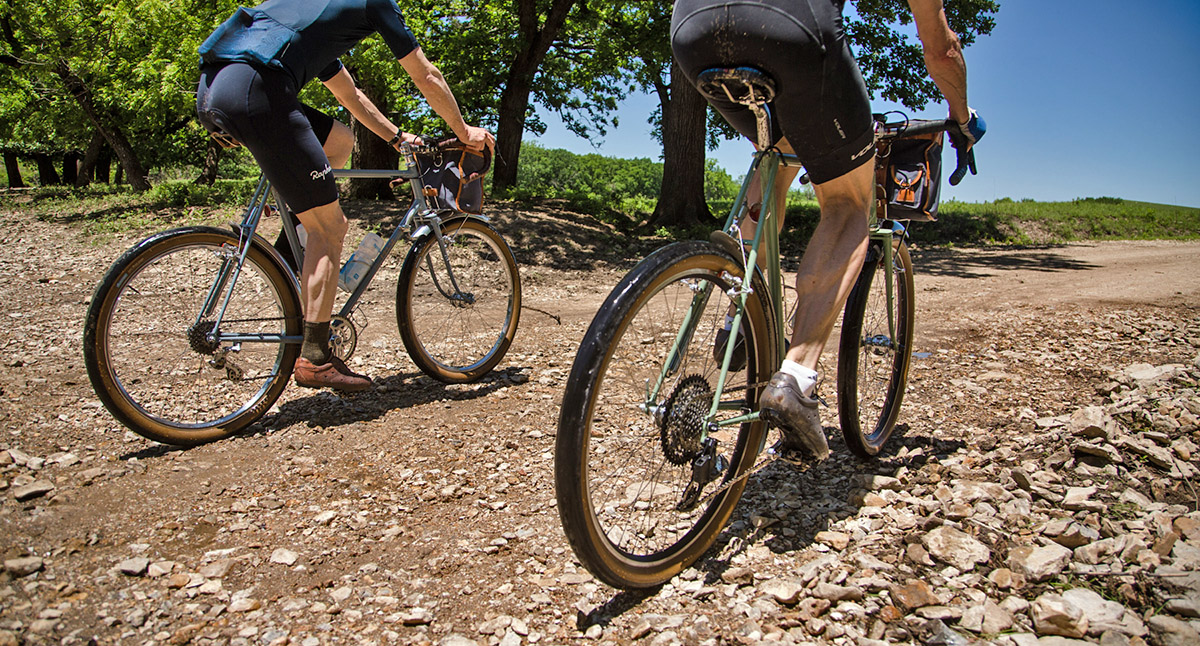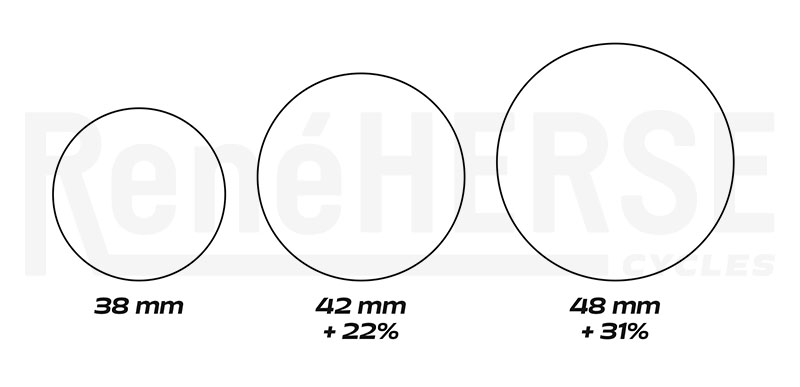Gravel Myths (1): Too Much Tire?
To start the new year, we’ll look at five ‘Gravel Myths.’ Things that are still touted by many in the media and the industry. And yet there’s no evidence to support those myths. Knowing how gravel bikes really work can help you make smarter equipment choices, go faster, be more comfortable, and have more fun.
Perhaps you’ve heard this when talking about an upcoming event or race: “I don’t want to run too much tire for that course.” At first sight, it makes sense: Speed is about compromise. The fastest bike uphill is the lightest one that doesn’t break. The most aero riding position is the lowest one that you can maintain for the distance and still put out maximum power. Along the same lines, wouldn’t the fastest tire be the narrowest one that you can run on the terrain ahead?
There’s a fallacy here: With weight, it’s obvious that lighter is better—even though most cyclists tend to overestimate the impact of a few grams saved. With aerodynamics, especially of cyclists, a smaller frontal area tends to be more aerodynamic. But tire size isn’t that simple. To illustrate this, consider the idea that a bigger gear will always be faster, provided you can still turn it smoothly. We all know that mashing big gears isn’t faster than spinning. In fact, the stronger the rider, the more they tend to spin their gears. (That is a topic for another day.)
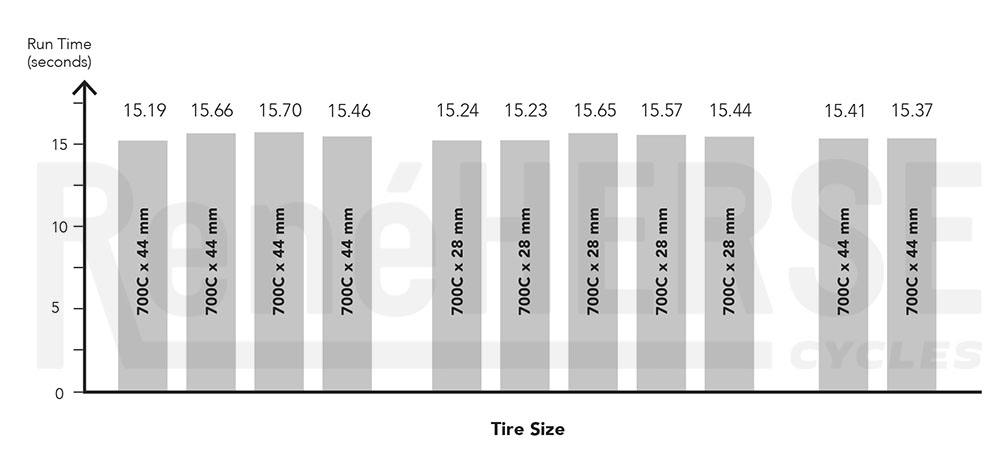
Smooth Roads
So let’s look at tire width. The most favorable scenario for narrow tires are smooth roads. We’ve tested this time and again. Above is a roll-down test of 44 and 28 mm tires (Rene Herse Snoqualmie Pass and Chinook Pass, both with Extralight casings). The average times for both tires are exactly the same. Neither tire was faster than the other.
The tests were done at typical gravel racing speed (29 km/h/18 mph). Conditions in this and all our other tests were carefully controlled. (No wind, constant temperature, exactly same rider position, etc.) Since we’re measuring actual speed, the data includes not just rolling resistance, but aerodynamics, too. We used Enve 45 wheels, which are aero-optimized for 28 mm tires. In theory, the 44 mm tires should be less aero, especially since the rims are optimized for the narrower tires, but this doesn’t show up in the real-world speeds.
Why aren’t the wide tires slower, or at least less aero? The reality is that a few millimeters in tire width don’t increase the frontal area of rider and bike by a lot. On most bikes, the down tubes are wider than the tires. Any potential aero advantages of narrow tires are so small that they get lost among other factors.
Smooth Road Summary: There’s no such thing as “too much tire” on smooth roads—at least up to 44 mm. Other tests have shown that even 54 mm-wide tires aren’t noticeably slower.
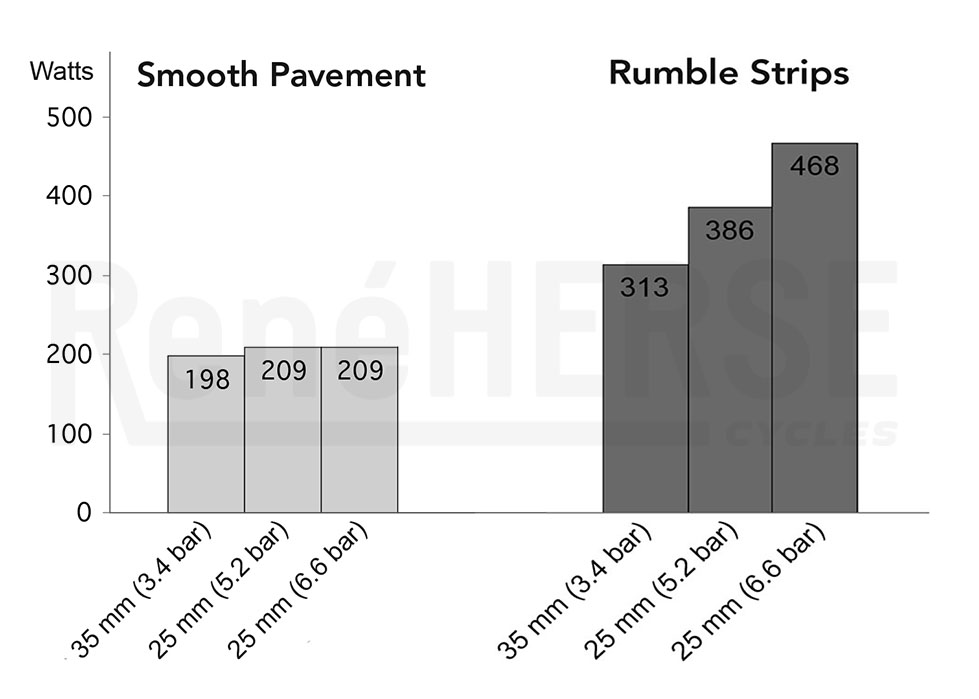
Rough Roads
What happens on rough roads? To test this, we ran a quiver of tires on brand-new, smooth pavement (left) and on rumble strips. (Rumble strips are indentations on the edge of highways to alert drivers who are drifting off the road.) Those two surfaces cover the extremes you’ll encounter in a gravel race, from ultra-smooth to extremely rough. We rode with a power meter at racing speed (31 km/h / 19.3 mph). We did that test years ago, so the tires are narrower than we’d test today, and the pressures are a bit higher, but the basic science applies to wider tires and lower pressures as well.
On the left are the results from the smooth pavement. You see—once again—that lower pressures don’t roll slower. With 25 mm tires, our tester needed 209 watts to ride at 31 km/h, regardless of whether the tires were inflated to 6.6 bar (95 psi) or 5.2 bar (75 psi). Switching to 35 mm tires and inflating them to 3.4 bar (50 psi) also made no difference. (The data show that the wider tires were slightly faster, but the difference is not statistically significant.)
On the right, you see that on the rough surface, you need to pedal harder. (No surprise!) How much harder depends on the width and pressure of your tires. If you run 25 mm tires at ultra-high pressure, you need to put out more than twice as much power when going from the smooth to the rough surface (+124%). With 35 mm tires are moderate pressure, you only need 50% more power. (The differences were statistically significant.)
Looking at the rough surface alone: Simply lowering the pressure in the 25 mm tires saved 82 watts, or 17%. Switching to wider tires and reducing the pressure even more saved another 73 watts. That means that going from one extreme—25 mm tires at high pressure—to a medium-width tire at moderate pressure required 1/3 less power—155 watts less. That’s huge! Of course, most gravel isn’t quite as rough as rumble strips, but you get the idea.
This trend continues with even wider tires and lower pressures, and it works in the real world, too, not just in carefully controlled tests. To set the FKT (Fastest Known Time) in the Oregon Outback, the 364-mile bikepacking route, I ran 54 mm tires at just 1.3 bar (19 psi). My tracker showed that my speed on rough and loose gravel was about 90% of my speed on pavement—with the same power output.
Why do wide tires provide such a huge advantage on rough surfaces? Even a small increase in width results in a large increase in air volume. A 42 mm tire (middle) is just 11% wider than a 38 mm (left), but it has 22% more air. If you go up to a 48 mm (right), you add another 31% in air volume. More air means more suspension, less vibrations, and hence more speed.
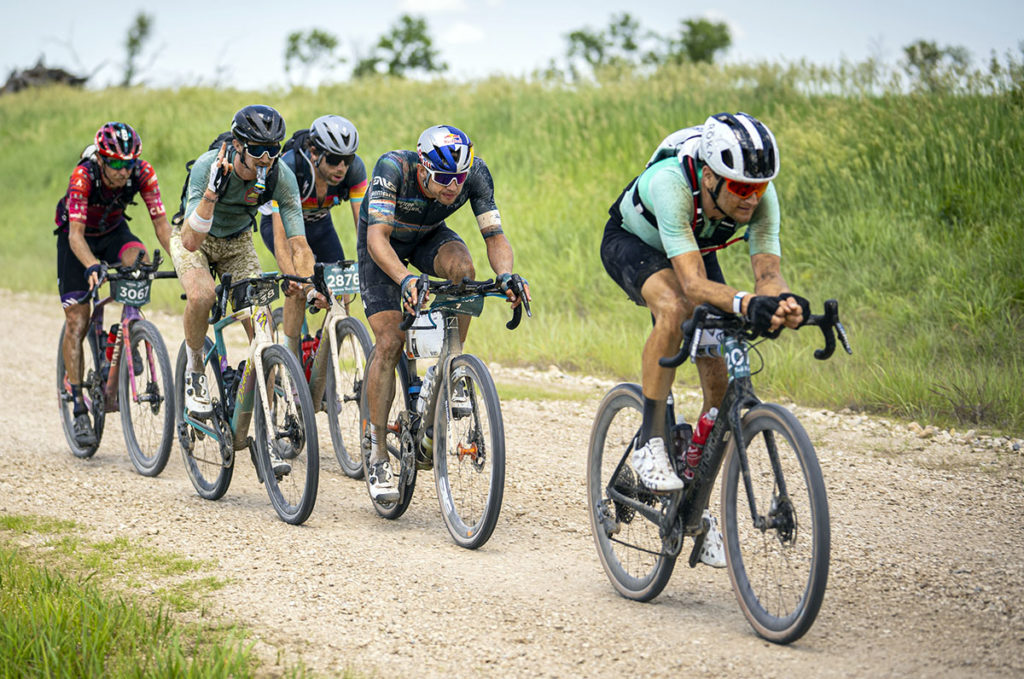
Other Factors
There are other factors to consider than just how fast a tire rolls over rough surfaces. Gravel races aren’t time trials. In addition to going as fast as possible with as little power as possible, racers need to react to accelerations. In theory, you’d want the lightest wheels possible. Since wider tires use more rubber, they inevitably weigh more. Does that mean wide tires put you at a disadvantage in a peloton? In the real world, the effect of (slightly) heavier tires is relatively small, and having fresh legs—because your tires have been faster-rolling all along—usually more than makes up for this.
Lower tire pressures change how a bike reacts and feels, especially in sprints. I could run my tires at 1.2 bar (19 psi) in the Oregon Outback, since that was an individual time trial. In a peloton, I’d want firmer tires to reduce the bounce when sprinting out of the saddle. Like everything, tire pressure is an individual thing—that’s why the Rene Herse tire pressure calculator shows two values, for ‘firm’ and ‘soft’ tire feel.
One other factor: Wider tires and lower pressures greatly reduce the risk of flatting or cutting a tire sidewall. That’s important: To win, you first need to finish!
Conclusion
There is no such thing as ‘too much tire’ for rides that include gravel. Even if most of the ride is on smooth pavement, wide tires don’t roll measurably slower there. And when the pavement ends, wide tires (and low pressures) are significantly faster. The advantage of wide tires on rough surfaces is huge. Their disadvantage on smooth roads—if it exists at all—is too small to measure in the real world. That’s why wide tires are a good choice even if 95% of a course are on smooth pavement—because you gain so much on the remaining 5% of rough surfaces. Greater durability is a further plus of wider tires.
The general trend in gravel racing confirms this. Just ten years ago, gravel racers argued over whether 25 or 28 mm tires were better for gravel racing, and 32 mm was generally considered ‘too much tire’ for most events. Today the same discussion continues, but with 38 or 42 mm tires. This doesn’t mean everybody should run always the widest tires possible: There are many considerations when choosing tires for gravel. But if you wonder whether you might be running ‘too much tire’ for a given course, don’t worry: You won’t be giving up any speed, and probably gain some, by going with wider tires.
Further Reading:
- Gravel Myths (2): Smaller Knobs Roll Faster?
- Gravel Myths (3): Wide Tires Need Wide Rims?
- Gravel Myths (4): 700C Wheels Roll Faster?
- Gravel Myths (5): Side Knobs for Cornering Traction?
- Aerodynamics of gravel bikes
- Our book The All-Road Bike Revolution goes into the details of how to make your bike fast, comfortable and reliable.
- Supple tires in the Rene Herse program
- Rene Herse Tire Pressure Calculator


